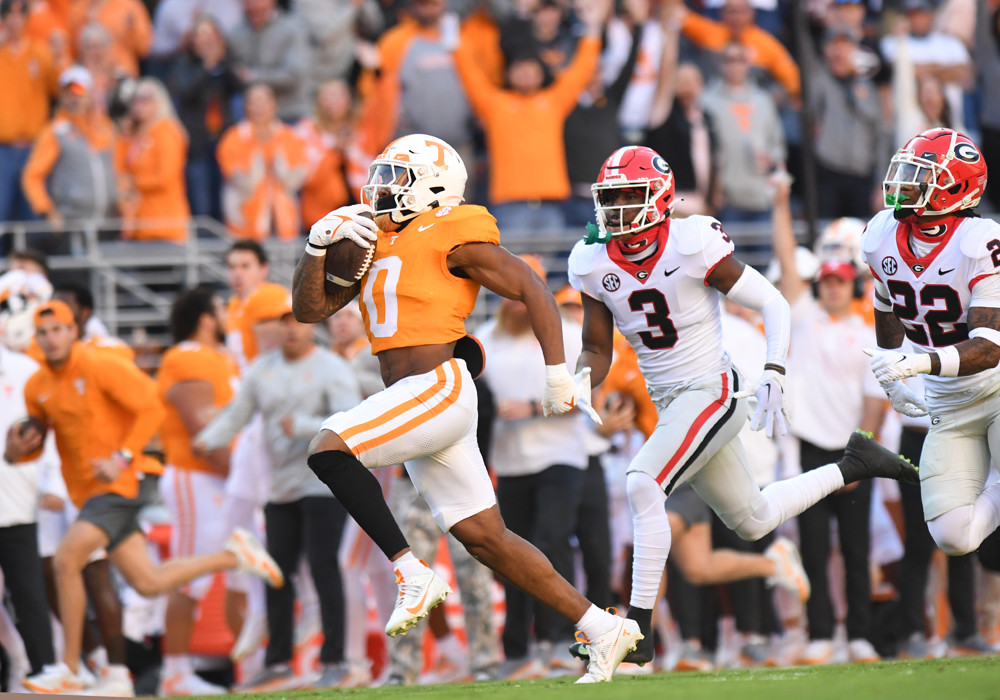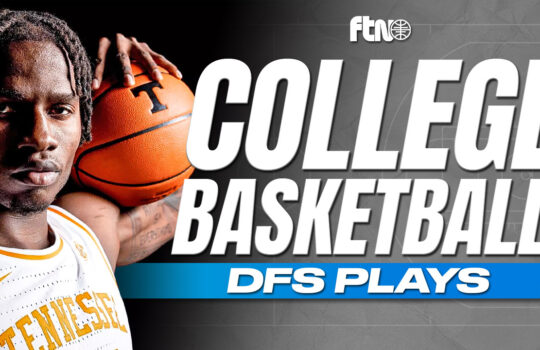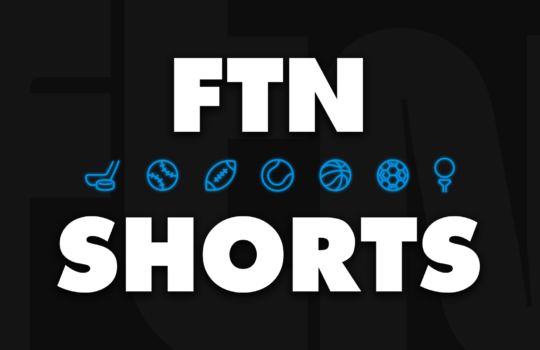
The NFL draft is upon us, which means the fantasy season is just around the corner. And while this draft class is seen as deep at key fantasy positions, experienced fantasy managers know that there will be plenty of rookies who will take time to contribute to the fantasy space.
In a previous article, I broke down the rookies who would offer an immediate fantasy impact. In this article, we will take time to break down prospects who will take time to provide fantasy value.
Make sure to check out FTN’s rookie scouting guide for more insight on the 2024 class ahead of the NFL draft.
Quarterback
Drake Maye, UNC
Drake Maye had a fantastic 2022 season and was seen as competition for the top overall quarterback in the draft class. In that season, Maye completed 66.2% of his passes for 4,321 yards and 38 touchdowns with seven interceptions. He also added 698 yards and seven touchdowns.
Unfortunately, most of Maye’s supporting cast graduated or left for the NFL, leading his play to suffer. Maye regressed both as a passer (63.3% completion percentage for 3,608 yards and 24 touchdowns with nine interceptions) and a rusher (449 rushing yards), but he did score nine rushing touchdowns. During that season, questions were raised about Maye’s decision-making and mechanics.
Even with that, Maye seems locked into being a first-round selection. In the right situation (Minnesota), any of these quarterbacks can perform in fantasy in 2024. However, Maye looks to be a raw prospect who could struggle without a strong supporting staff.
J.J. McCarthy, Michigan

J.J. McCarthy has seen his draft stock rise thanks to excellent interviews, a strong pro day and advanced metrics showing his ability to successfully pass in throwing situations during his tenure with Michigan. However, of all of the quarterback prospects in this class, McCarthy has the most question marks.
The former Wolverine attempted just 713 passes in his three collegiate seasons, never surpassing 332 in a season. McCarthy finished his collegiate career with a solid, but unremarkable 8.7 yards per attempt and had just 49 touchdowns with 11 interceptions in his career.
All indications are that McCarthy will be selected in the first six picks of the draft, and he even has some momentum toward being the second overall selection. And while McCarthy could eventually turn into the second-best quarterback in this class, it likely wouldn’t happen until he gets more repetitions after seldomly throwing (relative to the other top prospects) in college.
McCarthy would benefit from landing with a team that has a strong supporting cast, but that just might not happen given how high his draft stock has risen.
Running Back
Jonathon Brooks, Texas
Jonathon Brooks was buried behind Bijan Robinson and Roschon Johnson during his first two seasons with the Longhorns, accruing just 51 carries for 340 rushing yards and six touchdowns. Both Robinson and Johnson went to the NFL season after 2022, leaving Brooks with an excellent chance to take over the Longhorns’ backfield. And he took full advantage of that opportunity.
Brooks carried the ball 187 times for 1,139 yards and 10 touchdowns in 2023 while adding 25 receptions for 286 yards and a touchdown. Unfortunately, Brooks made it just 11 games before tearing his ACL. Had Brooks entered the draft process healthy, it seems very likely that he would have landed as the RB1 in this draft class. Realistically, that still may be the perspective of many teams in the league.
Even with solid draft capital, it will take time for Brooks to ramp back up. All signs indicate he will be ready for Week 1 of the regular season, but this will be a rookie running back who is not only trying to acclimate to the NFL but also trying to regain the strength in his knee. It’ll be difficult to trust the rookie running back during his first season in the league.
Jaylen Wright, Tennessee

Jaylen Wright came into the 2023 season after having a solid season rotating with Jabari Small in 2022 (146 carries for 875 yards and 10 touchdowns). Wright saw fewer carries in 2023 (137 carries) but turned into a big play machine. The junior running back set career highs in rushing yards (1,013) and yards per carry (7.4), but he did regress in the touchdown department (4). More importantly, Wright flashed his upside as a receiving threat, catching 22 passes for 141 yards.
Wright declared for the draft but inserted himself into the top of the running back rankings by erupting at the combine. The Tennessee product came in with a three-down running back build (5-foot-11, 210 pounds) and blazing a 4.38 40-yard dash.
Despite his effectiveness as an explosive rusher, it is telling that Wright never surpassed 150 carries in any season in his college career. That workload (and the Tennessee background) will draw comparisons to Alvin Kamara, but the film shows that Wright struggles to run the ball up the middle.
There may be big weeks during his first season thanks to his blend of size and speed, but there’s an equally strong chance that Wright finds himself as an explosive complement in some team’s backfield, relying on chunk gains on fewer touches. That role has plenty of fantasy appeal, but it may be a while before Wright is trusted with a larger role, which would cap his fantasy season in 2024.
Will Shipley, Clemson
During his tenure with Clemson, Will Shipley functioned as the team’s primary running back and workhorse. Shipley handled at least 149 carries in each of his three seasons and never finished with fewer than 700 rushing yards and five rushing touchdowns. The Clemson product also flashed solid receiving upside, twice surpassing 30 receptions and 200 receiving yards.
Shipley also performed well in the pre-draft process, measuring in at 5-11 and 206 pounds while running a 4.42 40-yard dash. Despite his collegiate production and solid size, Shipley isn’t viewed at the same level as running backs like Trey Benson and Jonathon Brooks in this draft class.
Draft capital will matter greatly for Shipley in 2024, but even in an ideal landing spot, he seems likely to see a role as a team’s pass-catching back who gets minimal carries in the ground game. While that role can be very lucrative (especially in PPR formats), it lacks an upside unless Shipley is operating as the primary back in the NFL.
If Shipley finds himself on a team with a crowded backfield, he could be seen as strictly a role player in his first season until an injury occurs, which significantly caps his upside in fantasy football.
Wide Receiver
Keon Coleman, Florida State
At the start of the 2023 season, it seemed like Keon Coleman could work his way firmly into the top 20 of the draft. Coleman, the Michigan State transfer, started his career at Florida State with 29 receptions for 418 yards (14.4 yards per reception) and seven touchdowns in six games. The wide receiver cooled off after that, catching just 21 passes for 240 yards and four touchdowns over his final six games.
Coleman’s draft profile got even more complicated during his combine performance. He measured in at 6-foot-3 and 213 pounds, giving him the size of an outside receiver. He followed that up with an underwhelming 4.61 40-yard dash. Even more confusing, Coleman was one of the fastest receivers to run the gauntlet drill, suggesting that his game speed is far better than his straight-line speed.
Coleman’s ability to produce in the NFL will depend on his utilization at the next level. On one hand, he has the build to be a jump ball receiver on the outside who can be a goal-line threat. Conversely, if he’s on the outside full time (and not used as a “big slot” receiver), he may struggle to create separation and earn targets. Either way, it could be a gradual acclimation to the NFL game as teams figure out the best way to utilize his size.
Adonai Mitchell, Texas
Adonai Mitchell struggled to produce consistently during his first two seasons with Georgia (38 receptions for 560 yards and seven touchdowns) and transferred to Texas before the 2023 season. Mitchell established himself as the WR2 with the Longhorns, posting career highs in receptions (55), yardage (845) and receiving touchdowns (11). The wide receiver never established himself as the top receiver on any of his collegiate teams, but he showed a penchant for showing up in big games (six career touchdown receptions in the College Football Playoffs).
Many view Mitchell as a player with untapped potential, an idea that was further supported by his strong combine testing performance (6-2 and 205 pounds with a 4.34 40-yard dash). On one hand, Mitchell offers a blend of size and speed that few other receivers offer. On the other, injuries and crowded depth charts led him to limited college production. Unlike other receivers in this class, Mitchell needs refinement as a route runner due to his lack of experience.
Mitchell could still land as a first-round pick due to his blend of size and speed (and a massive wide receiver need across the NFL), but it may take him time to earn a consistent role on the field.
Xavier Legette, South Carolina
Xavier Legette is one of the most intriguing prospects in the 2024 draft class. On one hand, Legette posted extremely underwhelming numbers during his first four seasons with South Carolina (42 receptions for 423 yards and five touchdowns) before breaking out with a huge 71 receptions for 1,255 yards and seven touchdowns in his fifth year. On the other hand, Legette lit up the combine after running a 4.39 40-yard dash at 6-foot-1 and 221 pounds.
Naturally, many are making comparisons to another former Gamecock in Deebo Samuel. Typically, players who take five years to break out struggle to find big success at the NFL level. However, Legette has enough yards after-the-catch ability in an NFL that values players who can make plays after the catch.
It’ll be hard to trust Legette in fantasy, but if he lands with a team that has shown the ability to creatively generate touches and get him the ball in space, then he can have a solid impact. But we have seen many iterations of Legette fail to make a major impact in the NFL after putting up big numbers of college to feel confident in that outcome.
Tight End
Theo Johnson, Penn State
The most important thing for tight ends making the leap from college to the NFL is athleticism. Few tight ends in this class possess more size and athleticism than Penn State’s Theo Johnson.
Johnson shocked at the combine when he ran a 4.57 40-yard dash at 6-6 and 259 pounds. Unfortunately, that explosiveness didn’t manifest in much college production in the Big10 after Johnson accrued just 77 receptions for 938 yards and 12 touchdowns in four seasons. Johnson struggled to stand out in Penn State’s run-heavy offense, but he has the requisite size and burst to emerge as a threat at the NFL level.
Drafting Theo Johnson is gambling that his athletic traits will help him find a role in the NFL while he learns the nuances of his position. It may take several seasons for Johnson to break out, but if he does, he has the makings of the next great tight end.
Erick All, Iowa
Erick All started his college career at Michigan but struggled to see a major role in the offense thanks to various injuries. In his first four seasons with the Wolverines (22 games), All caught 54 passes for 565 yards and two touchdowns. His best season was his healthiest season in 2021, where he played 13 games and caught 38 passes for 437 yards and two touchdowns.
All decided to transfer to Iowa for his fifth year and immediately earned a role in Iowa’s limited passing attack. All finished fourth on the team in receptions (21), first in receiving yards (299) and first in receiving touchdowns (3). He did that despite suffering an injury that limited him to just seven games.
All have solid route running ability and showed that he can earn targets and make plays after the catch. He’s a former four-star recruit who showed the ability to produce at two different Big10 programs despite injury limitations. If he can land with an NFL team and stay healthy enough to develop, he has all of the physical ability to contribute to fantasy football. Fantasy managers who draft him shouldn’t expect much to start his career.















































 New York Jets
New York Jets  New England Patriots
New England Patriots  Miami Dolphins
Miami Dolphins  Buffalo Bills
Buffalo Bills  Pittsburgh Steelers
Pittsburgh Steelers  Cleveland Browns
Cleveland Browns  Cincinnati Bengals
Cincinnati Bengals  Baltimore Ravens
Baltimore Ravens  Tennessee Titans
Tennessee Titans  Jacksonville Jaguars
Jacksonville Jaguars  Indianapolis Colts
Indianapolis Colts  Houston Texans
Houston Texans  Las Vegas Raiders
Las Vegas Raiders  Los Angeles Chargers
Los Angeles Chargers  Kansas City Chiefs
Kansas City Chiefs  Denver Broncos
Denver Broncos  Washington Commanders
Washington Commanders  Philadelphia Eagles
Philadelphia Eagles  New York Giants
New York Giants  Dallas Cowboys
Dallas Cowboys  Minnesota Vikings
Minnesota Vikings  Green Bay Packers
Green Bay Packers  Detroit Lions
Detroit Lions  Chicago Bears
Chicago Bears  Tampa Bay Buccaneers
Tampa Bay Buccaneers  New Orleans Saints
New Orleans Saints  Carolina Panthers
Carolina Panthers  Atlanta Falcons
Atlanta Falcons  San Francisco 49ers
San Francisco 49ers  Seattle Seahawks
Seattle Seahawks  Los Angeles Rams
Los Angeles Rams  Arizona Cardinals
Arizona Cardinals 









 Boston Celtics
Boston Celtics  Brooklyn Nets
Brooklyn Nets  Philadelphia 76ers
Philadelphia 76ers  New York Knicks
New York Knicks  Toronto Raptors
Toronto Raptors  Chicago Bulls
Chicago Bulls  Detroit Pistons
Detroit Pistons  Milwaukee Bucks
Milwaukee Bucks  Cleveland Cavaliers
Cleveland Cavaliers  Indiana Pacers
Indiana Pacers  Orlando Magic
Orlando Magic  Atlanta Hawks
Atlanta Hawks  Charlotte Hornets
Charlotte Hornets  Miami Heat
Miami Heat  Washington Wizards
Washington Wizards  Denver Nuggets
Denver Nuggets  Minnesota Timberwolves
Minnesota Timberwolves  Oklahoma City Thunder
Oklahoma City Thunder  Portland Trail Blazers
Portland Trail Blazers  Utah Jazz
Utah Jazz  LA Clippers
LA Clippers  Golden State Warriors
Golden State Warriors  Los Angeles Lakers
Los Angeles Lakers  Phoenix Suns
Phoenix Suns  Sacramento Kings
Sacramento Kings  Dallas Mavericks
Dallas Mavericks  Houston Rockets
Houston Rockets  Memphis Grizzlies
Memphis Grizzlies  New Orleans Pelicans
New Orleans Pelicans  San Antonio Spurs
San Antonio Spurs 










